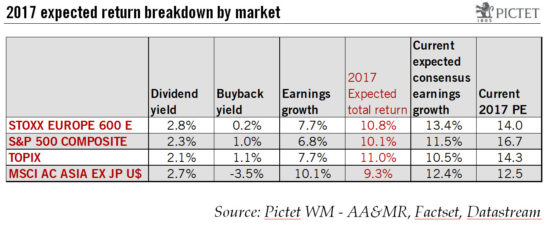According to our risk factor-based analysis, equities are likely to provide a total return of around 10% on average next year.Major equity markets are likely to deliver a total return of around 10% in 2017 according to our risk factor-based analysis framework. This projection is contingent on two market risk factors, i.e. equity and interest rates.We use four building blocks in our calculation of projected equity returns: dividend yield, buyback yield, valuation and earnings growth.The dividend yield and the buyback yield produce shareholders’ cash return. Dividend yield tends to be fairly stable over time. We do not expect any significant shift in this trend in the foreseeable future. Our expected dividend yields for major equity markets in 2017 are close to the 10-year median. Forecasting the buyback yield is more challenging. However, in spite of rising US interest rates, US companies should continue to buy back their shares in 2017, although at a slower rate than before. In Europe, buyback yields may remain only slightly above zero as European companies still tend to favour dividends over buybacks, unlike US companies. In Japan, regulatory incentives for buybacks are strong and buyback yield is expected to stand at around 1% in 2017.
Topics:
Wilhelm Sissener and Jacques Henry considers the following as important: Equity forecast, Macroview, Market forecasts, Projected equity returns
This could be interesting, too:
Cesar Perez Ruiz writes Weekly View – Big Splits
Cesar Perez Ruiz writes Weekly View – Central Bank Halloween
Cesar Perez Ruiz writes Weekly View – Widening bottlenecks
Cesar Perez Ruiz writes Weekly View – Debt ceiling deadline postponed
According to our risk factor-based analysis, equities are likely to provide a total return of around 10% on average next year.

Major equity markets are likely to deliver a total return of around 10% in 2017 according to our risk factor-based analysis framework. This projection is contingent on two market risk factors, i.e. equity and interest rates.
We use four building blocks in our calculation of projected equity returns: dividend yield, buyback yield, valuation and earnings growth.
The dividend yield and the buyback yield produce shareholders’ cash return. Dividend yield tends to be fairly stable over time. We do not expect any significant shift in this trend in the foreseeable future. Our expected dividend yields for major equity markets in 2017 are close to the 10-year median. Forecasting the buyback yield is more challenging. However, in spite of rising US interest rates, US companies should continue to buy back their shares in 2017, although at a slower rate than before. In Europe, buyback yields may remain only slightly above zero as European companies still tend to favour dividends over buybacks, unlike US companies. In Japan, regulatory incentives for buybacks are strong and buyback yield is expected to stand at around 1% in 2017.
All in all, dividend yield and buyback yield may together add up to around 3% of the 10% expected total return figure we expect in 2017 for every major market, except for Asian equity markets, where their sum is slightly negative.
Earnings growth is expected to be the key risk factor for equities in 2017. After five years of consistent downward revisions in earnings estimates and only anaemic growth in 2015 and 2016, earnings growth is expected to recover again. Current consensus expectations for 2017 earnings growth range from +11% to +13% in major equity markets. Risks to earnings growth forecasts are tilted to the upside owing to president-elect Donald Trump’s proposed US corporate tax reforms.
The oil & gas sector alone is expected to account for 3.5% of total earnings growth of 11.5% in the US and 2.6% of total earnings growth of 13.5% in Europe. Financials, and especially banks, should experience stronger earnings growth in 2017 as a result of higher interest rates.
Of the four blocks, valuation is likely to have the least impact next year. Valuations are already stretched and suggest no leeway for further expansion. But the negative effect of rising interest rates on valuations should be offset by higher inflation and higher nominal economic growth.
